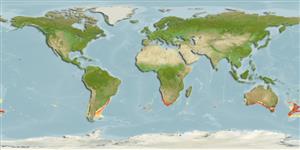Environment: milieu / climate zone / Tiefenbereich / distribution range
Ökologie
seewasser demersal; tiefenbereich 50 - 854 m (Ref. 52581). Subtropical; 28°S - 50°S, 180°W - 180°E
Circumglobal in southern waters: (Ref. 7300): South Africa, Australia, New Zealand, Kermadec I., Desventuradas Is., Juan Fernandez Is., Chile, north to southern Brazil, Tristan da Cunha.
Length at first maturity / Size / Gewicht / Alter
Geschlechtsreife: Lm 88.0 range ? - ? cm
Max length : 160 cm TL Männchen/unbestimmt; (Ref. 89467); common length : 100.0 cm TL Männchen/unbestimmt; (Ref. 9258); max. veröff. Gewicht: 100.0 kg (Ref. 4537); max. veröff. Alter: 60 Jahre (Ref. 41439)
Rückenflossenstacheln (insgesamt) : 9 - 12; Rückenflossenweichstrahlen (insgesamt) : 12; Afterflossenstacheln: 3; Afterflossenweichstrahlen: 7 - 9.
Body shape (shape guide): fusiform / normal.
A deepwater species, occurs in seamounts (Ref. 89357). Adults occur generally over rough ground from the central shelf (about 100 m) to the shelf edge and down to the upper slope. Juveniles are found in surface waters, perhaps school in association with drifting weed. Feed on barracouta and pilchards, in addition to various bottom-dwelling fish. Are primary gonochorists (Ref. 58421). Preyed upon by sperm whales (Ref. 9072). It is taken by droplining down to 400 m, and is sometimes seen in the trawled catch. Utilized fresh and frozen; can be steamed, fried, broiled, boiled, microwaved and baked (Ref. 9988). Severely overfished (Ref. 89357).
Are primary gonochorists (Ref. 58421).
Paxton, J.R., D.F. Hoese, G.R. Allen and J.E. Hanley, 1989. Pisces. Petromyzontidae to Carangidae. Zoological Catalogue of Australia, Vol. 7. Australian Government Publishing Service, Canberra, 665 p. (Ref. 7300)
IUCN Rote Liste Status (Ref. 130435: Version 2025-1)
Bedrohung für Menschen
Harmless
Nutzung durch Menschen
Fischereien: kommerziell; Sportfisch: ja
Tools
Zusatzinformationen
Download XML
Internet Quellen
Estimates based on models
Preferred temperature (Ref.
123201): 8.6 - 16, mean 11.7 °C (based on 143 cells).
Phylogenetic diversity index (Ref.
82804): PD
50 = 1.0000 [Uniqueness, from 0.5 = low to 2.0 = high].
Bayesian length-weight: a=0.01072 (0.00765 - 0.01501), b=3.00 (2.90 - 3.10), in cm total length, based on LWR estimates for this species (Ref.
93245).
Trophic level (Ref.
69278): 4.5 ±0.77 se; based on food items.
Widerstandsfähigkeit (Ref.
120179): sehr niedrig, Verdopplung der Population dauert mehr als 14 Jahre. (tm=10-13; tmax=60).
Fishing Vulnerability (Ref.
59153): High vulnerability (59 of 100).
🛈
Climate Vulnerability (Ref.
125649): High to very high vulnerability (70 of 100).
🛈
Nutrients (Ref.
124155): Calcium = 34 [20, 61] mg/100g; Iron = 0.904 [0.538, 1.528] mg/100g; Protein = 21 [20, 22] %; Omega3 = 0.563 [0.318, 1.046] g/100g; Selenium = 55.6 [29.6, 108.8] μg/100g; VitaminA = 9.09 [3.16, 24.94] μg/100g; Zinc = 0.368 [0.267, 0.532] mg/100g (wet weight); based on
nutrient studies.
